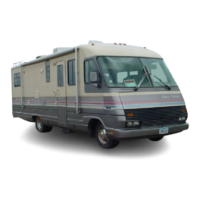and/or obstmctions near your motor home.
You
must monitor them constantly while you are driv-
ing. Become familiar with the operation
of
the
side
minurs and leam to use them to view objects
and the road beside and behind the motor home.
The rear view mirrors are controlled from a
panel located on the driver's left side instmment
panel. To adjust the mirrors, select either LEFT
or RIGHT mirror and press the appropriate
arrow. Activate the mirror heaters (if equipped)
by pressing the HEATER position.
Remember that your motor home is heavier than
a car, making it less maneuverable and harder to
stop. Also, because
of
its greater side surface
area, it
is
more easily affected by cross winds.
Allow extra distances for passing and stopping.
v'1
NOTE
I
Although your motor home is equipped
with
power
steering,
the
front wheels may be difficult to turn
when
at
a dead
stop.
When
maneuvering
in
some
close situations, give yourself some room
to
move
either forward or backward.
The
vehicle has to be in
motion for the front wheels
to
be turned with
ease.
Driving
on
winding or mountain roads
is
not
difficult
if
done with reasonable care. Observe
proper vehicle speeds when ascending or
descending hills and always operate in the
proper transmission range. Downshift on hills to
avoid overheating
or
undue engine loads.
Downshift when descending grades.
Engine compression and friction will help con-
trol vehicle speed, and relieve some
of
the strain
on the brakes. Shift the transmission to a lower
gear before starting down the grade.
Mountain driving or desert temperatures can put
extreme demands
on
drive train components.
Under extreme heat conditions you may need to
tum off the vehicle air conditioner to improve
engine and transmission cooling.
Be aware
of
the extra height
of
your motor
home. Check for low hanging tree branches or
other obstmctions whenever you drive or park.
Avoid low overhangs when pulling in for serv-
On
The
Road
ice. Always check.overhead clearances
of
over-
passes and bridges.
This may be particularly
important
if
you drive with the overhead vents
open or
if
the motor home
is
equipped with a
roof
air conditioner,
roof
rack, CB or
TV/
radio/satellite antenna.
Before leaving on a trip, check your route. Some
tunnels prohibit motor homes with
LP gas systems.
When parking parallel to a curb, be sure to
allow for poles or obstmctions
as
the front and
rear portions
of
the motor home swing wider
than an automobile. When parking on an
incline, tum the front wheels into the curb in the
direction
of
the roll to aid the parking brake.
When parking, always shift the transmission to
P and set the parking brake.
If
you
can't
avoid operating, parking or idling
your vehicle off-road:
•
Be
aware that combustible materials could
catch fire
from the vehicle's
hot
exhaust
system.
• Avoid driving your vehicle through or over
combustible
mawrials such as leaves, grass,
vegetation or stabble high enough
to
touch,
catch or collect
on
its
hot
exhaust system.
• Parking or idling should be done only
in
an area where there are no combustible
materials under the vehicle.
it..
WARNING
Do
not park or idle the motor home over combustible
materials such
as
tall grass or dried leaves.
Combustible materials may catch fire from the hot
exhaust gases, soot or sparks that
could escape
through corrosion
holes or cracks. This
is
particularly
important
if
the exhaust system has not been properly
maintained.
REAR VIEW VIDEO MONITOR
(If
Equipped)
If your motor home is equipped with rear view
video monitor, the camera is located at the top
rear
of
the motor home. The rear view picture is
05-13

